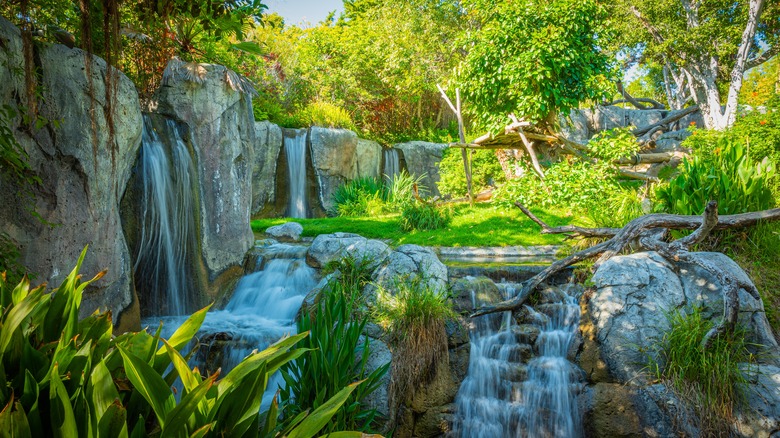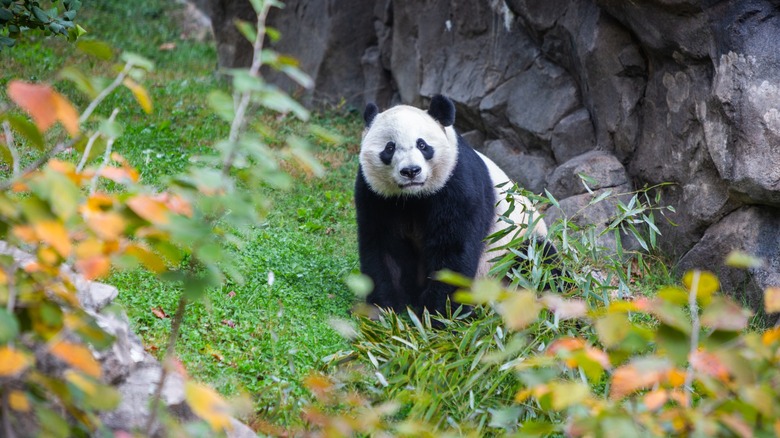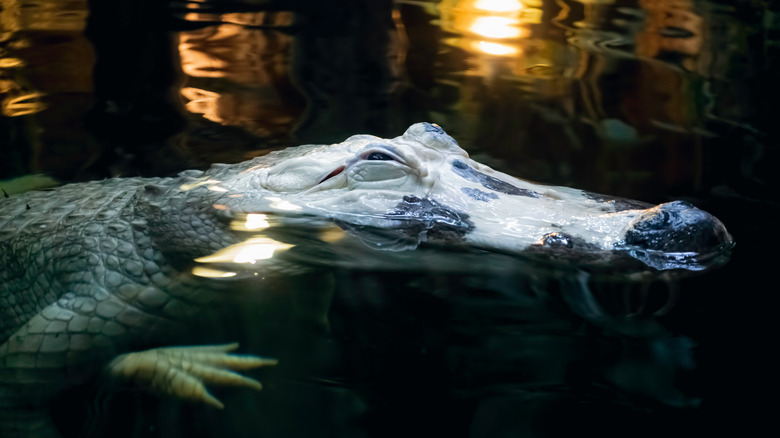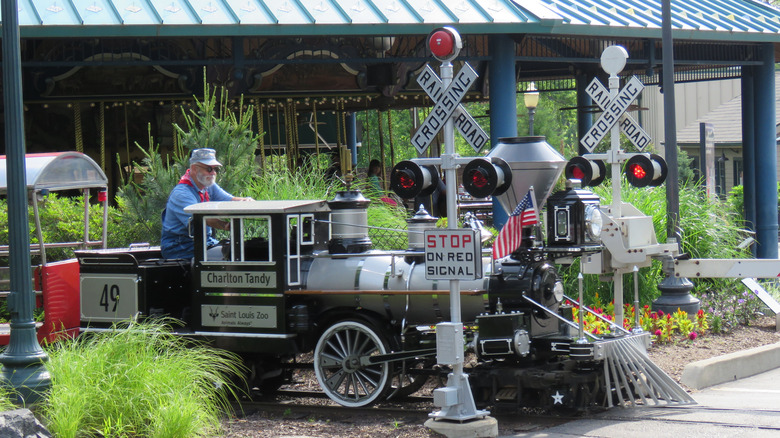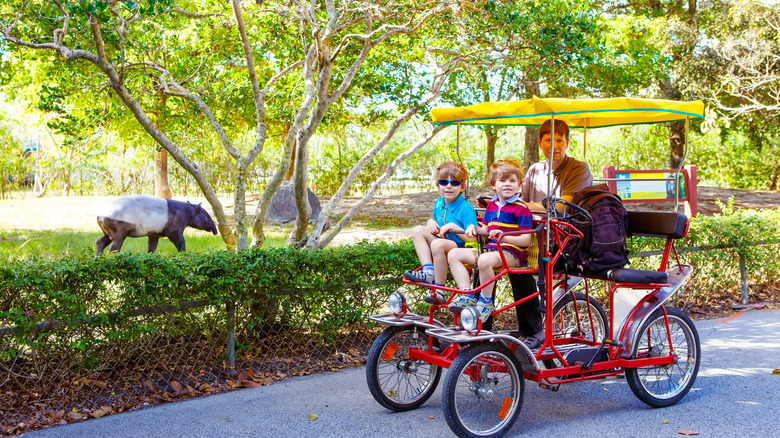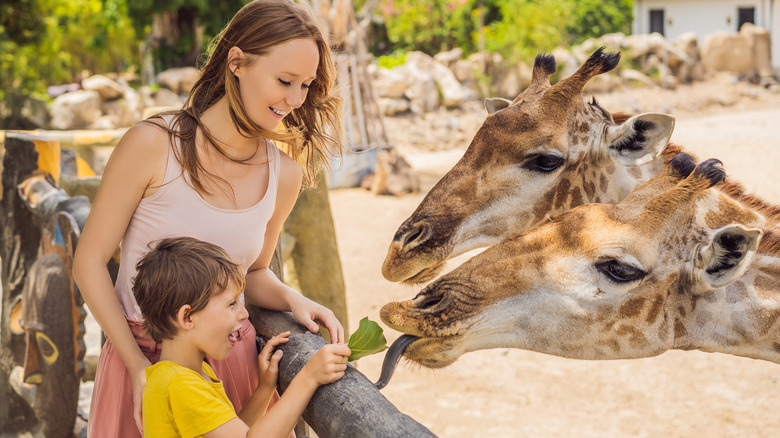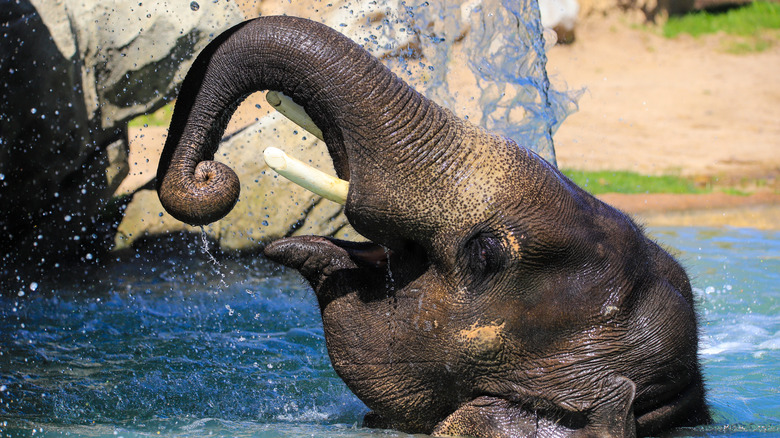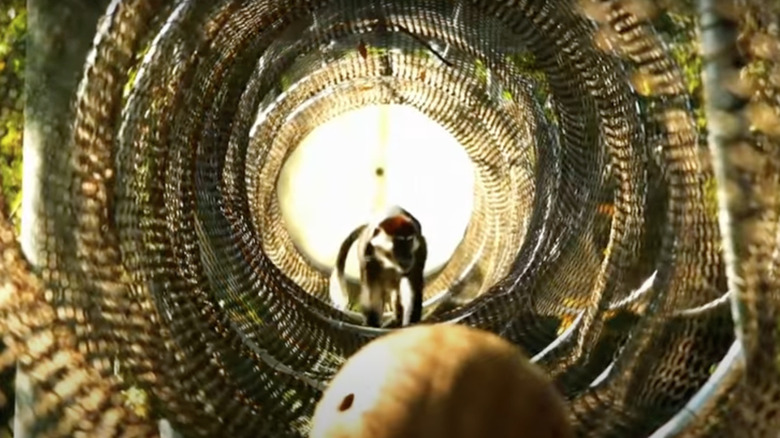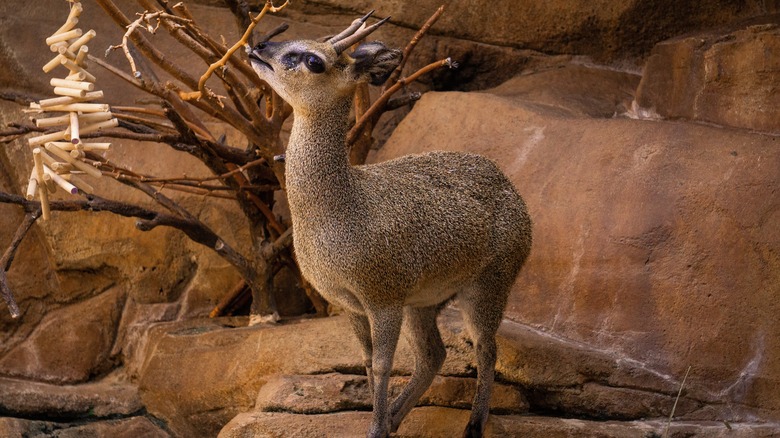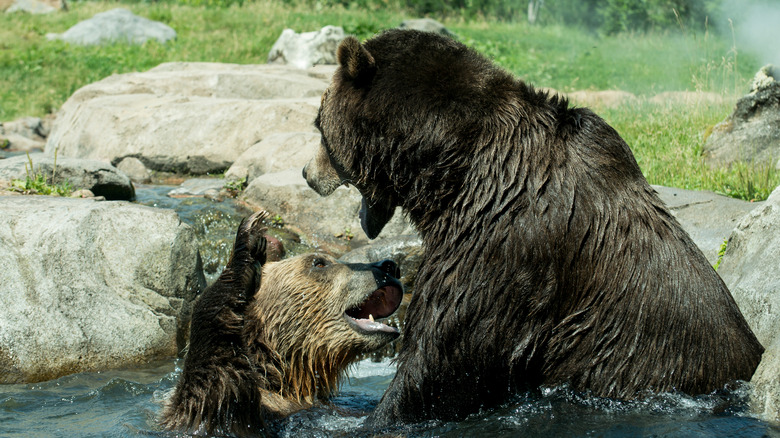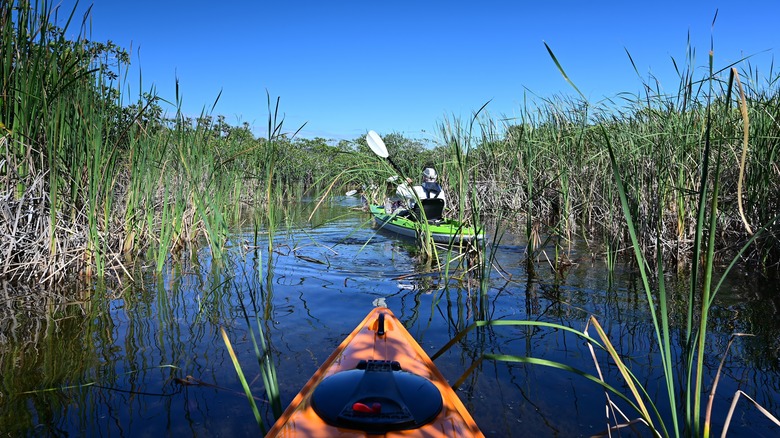Incredible Zoos To Visit Across America
Going to the zoo is a classic activity — the kind of outing, for both young and old, that's immortalized in storybooks and movies and is an institution in American culture. They have undoubtedly had a checkered past, particularly in relation to the level of care and quality of the habitats provided to the animals that call them home. Now, however, the narrative has shifted to one of protection and celebrating biodiversity rather than just entertainment. Many zoos now serve as critical hubs for conservation and education as much as tourist destinations.
Coast to coast, from California to Florida, the U.S. boasts an array of incredible zoos that blend ecological innovation with enjoyment and leisure. You can immerse yourself in the beauty of local ecosystems or be transported to the farthest reaches of the planet, encountering creatures big and small, rare and endangered, in settings that mimic their native environments. And, from zip-lines to kayaking tours, and 4D movie theaters to antique carousels, these remarkable zoos offer more than just encounters with nature and animals. Whether you're a family looking to ignite a passion for the planet or a seasoned wildlife enthusiast, here are the best places in the U.S. to forge unforgettable memories and a renewed appreciation of the natural world.
San Diego Zoo (San Diego, California)
The San Diego Zoo has a rich history, which spans more than 100 years. First opened in 1916, this world-renowned zoo is an institution in the city and has been entertaining visitors to San Diego for many years with its extensive collection of wildlife. Situated in Balboa Park, the city's museum and cultural heartland, it is easily accessible from downtown and remains one of its most popular attractions for visitors of all ages. Today, ticket sales help to fund important projects driving conservation solutions around the globe.
There are over 100 acres of parkland to explore and the botanical gardens are as much of a draw as the 12,000 animals, so you'll need to plan a one-day San Diego Zoo itinerary pretty effectively. The vast area is divided into different zones, from the Outback to the Northern Frontier, where flora and landscaping mimic the natural habitats of each region. This offers visitors the chance to truly immerse themselves in these exotic worlds, as well as providing the animals with the most natural experience possible. A highlight is the Scripps Aviary, where colorful birds fly around you, and you can also enjoy the sights and scents of plants native to lush African rainforests. There's even a waterfall flowing gently nearby.
Because it's spread over such a large area, planning before you go is essential. The best way to see the zoo as a whole, however, is from the sky: an aerial tram glides over the treetops for spectacular views of the zoo below, and out to Balboa Park beyond.
Smithsonian's National Zoo (Washington, D.C.)
There are 18 distinct areas to explore at the Smithsonian's National Zoo, which also extends over more than one hundred acres of land in the middle of a city. It is situated in the capital's residential neighborhood of Woodley Park, convenient for arriving by both the metro and bus. However, you should be prepared for lots of walking on the other side of the gates in order to get the most out of your visit!
More than 2 million people flock to this zoo each year, and it's easy to see why. From their famous endangered Giant Pandas to tiny tree frogs, there's a huge range of wildlife to enjoy. What's more, although entry passes with a specified access time are required — and these are best booked in advance online to avoid disappointment — entry to the zoo is completely free. The Smithsonian Conservation Biology Institute is also a global research center. It is at the forefront of attempts to save endangered species and habitats across the world, as well as inspiring the next generation to actively participate in conversation efforts. The scientists and expert keepers who work here showcase their zoological knowledge through dozens of daily feedings and talks.
Audubon Zoo (New Orleans, Louisiana)
This NOLA landmark dates back as far as the 1884 World Fair that was held in Audubon Park in Uptown New Orleans. Over the years, new animal exhibits and specialist enclosures have been added to the original site, including the largest free-flight aviary in the region and a new aquarium and insectarium. Now, it is home to a wide range of innovative habitats, from the Jaguar Jungle, with its recreated Mayan ruins and lush flora, to the heights of Monkey Hill — the tallest point in the whole of the city — which provides a treehouse, slides, and rope bridges for its primate residents.
Although it is now a key contributor to global and local conservation projects, Audubon Zoo retains much of the romance and charm of a historic zoo, with century-old oak trees and an elegant 1920s sea lion pool. However, the most unique attraction is the Louisiana Swamp, where visitors can experience this distinct local ecosystem and a taste of Cajun culture right in the heart of the city. There are white alligators, water snakes, blue crabs, and red foxes to be glimpsed here, as well as lots of information about both Cajun heritage and protecting the future existence of the swamps and their biodiversity. Needless to say, exploring this zoo is one of the best things to do when visiting New Orleans.
Oregon Zoo (Portland, Oregon)
There are more than 2,600 different animals in residence at Oregon Zoo. Although is the oldest zoo to be found west of the Mississippi, it has seen many recent renovations and expansions, with a mission to provide as much space and natural habitat as possible. The Elephant Lands exhibit is one such example – a free-flow environment of mud wallows, water features, and deep sand that includes one of the largest indoor enclosures for elephants in the world.
There's also a new, innovative space for the polar bears that has rugged terrain that has been used to recreate the Arctic Tundra landscape that they call home in the wild. There are also two saltwater plunge pools for the bears to swim in, which help keep their fur and skin healthy, and plenty of spots from which visitors can watch these magnificent creatures. There's even a "smell port" where you can come nose to nose with the bears!
Oregon Zoo is renowned for its high standards of animal care and conservation efforts, both within the Pacific Northwest and overseas. It is committed to supporting species that are endangered or threatened in the local area, as well as projects with global reach. These local initiatives range include breeding the magnificent California Condors, successfully reintroducing some of the birds back into the wild, and protecting the tiny Oregon silverspot butterfly.
Saint Louis Zoo (St. Louis, Missouri)
The Saint Louis Zoo is an excellent choice for travelers on a budget — admission here is free, and there's an impressive range of 16,000 animals and 500 species for you to encounter without spending a dime. You can enjoy the sight of sea lions playing and frolicking as you walk beneath their pool through the underground tunnel, experience a close encounter with a swimming polar bear, and surround yourself with the lush flora of the River's Edge. Centered around river ecosystems, with flora and fauna from across four different continents, the River's Edge was the first immersive exhibit at the zoo.
Although some of the other attractions require you to purchase tickets, the Saint Louis Zoo is home to an impressive range of entertainment options for the whole family. You can ride on the miniature Zooline railway (which operates a hop-on, hop-off service all day for a reasonable price), watch a movie at the 4D theater, or catch one of the seasonal bird, stingray, mechanical dinosaur, or sea lion shows. There are also festivals and film screenings held here regularly, such as the Zootoberfest, which combines bands, beer, and animal-themed fun each October.
Zoo Miami (Miami, Florida)
The vast Zoo Miami is the largest zoo in the state of Florida, and one of the largest in the whole of the U.S. It is spread out over 750 acres, with miles of paths from which to enjoy the 500 different species of creatures that call this zoo home. It's known for its lush vegetation as well as its wildlife — there are more than 4,000 flowers and trees living here, too. To help you make the most of your visit, you can rent a Safari Cycle, a family-sized pedal bike, or a motorized "Rydable" animal, in order to traverse the large site. You can also take a boat tour through the Everglades exhibit.
Located in Miami-Dade County in southern Florida, it's also the only zoo in the continental United States with a natural subtropical climate. This means that Zoo Miami is able to take advantage of the mild winters and humid summers of the region to carefully recreate the habitats of exotic creatures — and plants — from around the world. Many of the exhibits are open-air, from the Wings of Asia free-flight aviary, to the river otters and Florida panthers of the Everglades, to the wetlands of South America.
The zoo is also renowned for its breeding programs and conservation work, having won awards for their efforts with endangered species such as Komodo dragons and Cuban crocodiles. A ride on their antique wooden carousel, which features hand-carved animals, helps to fund these projects.
Chicago Zoological Society Brookfield Zoo (Brookfield, Illinois)
Located just outside Chicago, Brookfield Zoo features innovative exhibits, a commitment to zoological education, and plenty of fun for visitors of all ages. One of the highlights is just how close you can get to the wildlife at this zoo. Peacocks roam the expanse of parkland freely among the guests, the large Hamill Family Wild Encounters attraction allows you to pet wallabies, reindeer, goats, and other animals, and you can even feed the giraffes their lunch! You can purchase (for an additional cost) greens and other suitable snacks for the chance to feed these magnificent animals with your own hands.
Although you'll need to plan ahead, as there are limited spaces available for the Penguin Encounter, you can also meet and greet the Humboldt penguins as you learn about their lives and care at Brookfield Zoo, as well as the conservation efforts of the Chicago Zoological Society with penguins in the wild in Peru. The rest of the 235-acre site is split into different zones, such as Tropic World, which is home to the zoo's monkey population, the Rainforest, where clouded leopards roam, and the Great Bear Wilderness where you'll be able to look for wolves and grizzly bears. Fortunately, there's a tram — Safari Tours — that runs through the park to help you reach your favorite areas quickly and conveniently during your visit.
Denver Zoo (Denver, Colorado)
The Denver Zoo, similarly, has a strong focus on education and conservation — they donate nearly $2 million a year to programs helping to safeguard the future of the natural world and offer a range of daily talks and demonstrations to teach visitors about the animals who call the zoo home. They're also committed to being open to everyone who wants to come and learn about the animals and their care, offering a number of free visiting days over the course of the year.
This is one of the most popular zoos in the U.S. thanks to the immersive and innovative exhibits that offer both an exciting experience for guests and some of the most natural environments possible for the 4,000 creatures who live there. Penguin Point, for example, has a vast 10,000-gallon pool for the penguins to enjoy. It is modeled on their wild habitats and the size allows them to indulge in their favorite pastimes, like swimming and diving. There's even a wavemaker to simulate the ocean currents! Likewise, the Toyota Elephant Passage is a complex, multi-species space that allows elephants, tapirs, and rhinos to roam freely through more than 10 acres in order to mimic the space and freedom they would find in tropical Asia.
Philadelphia Zoo (Philadelphia, Pennsylvania)
Significantly smaller than many of the other major zoos, the Philadelphia Zoo is only 42 acres. However, it's the nation's oldest zoo, having first opened its doors more than 160 years ago. Today, you can enjoy its diverse collection of animals alongside the Victorian architecture and historic botanical gardens. It is also known for one of the most groundbreaking modern exhibits in the U.S. The Zoo360 is a unique travel system for the animals, connecting different habitats together with trails that are built up above the main pathways around the zoo. These allow the big cats and primates to move more freely around the site. It gives the animals more space to roam and explore, but it also provides an extraordinary experience for visitors as they watch these majestic beasts cross paths above their heads!
In addition, you can walk among the ring-tailed and mongoose lemurs on their island, feed a family of giraffes by hand, and enjoy the colorful birds soaring overhead in the free-flight aviary. There's also a dedicated space for younger visitors — the KidZooU — that has interactive elements to engage kids in the zoo's mission, plus a Rare Animal Conservation Center that houses critically endangered species such as the Pied tamarin monkey.
Henry Doorly Zoo and Aquarium (Omaha, Nebraska)
Nebraska may be one of the least-visited states in the U.S., but over 2 million visitors cross the threshold of the Henry Doorly Zoo and Aquarium in Omaha each year — and that's because this remarkable zoo is home to many of the leading wildlife exhibits in the world. The record-breaking facilities include the largest indoor rainforest in America, plus the world's largest indoor desert, nocturnal exhibit, and indoor swamp.
The zoo covers more than 130 acres, although its most popular attractions are conveniently situated near the entrance. Start your journey in the iconic Desert Dome — 84,000 square feet of plants and animals from three different deserts around the globe. The attraction features mountains, sand dunes, and even its own Rattlesnake Canyon, and underneath the geodesic dome, you can explore the Kingdoms of the Night exhibit, which is home to bats, wallabies, echidna, crocodiles, turtles, and fish. Afterward, head back up into the sunlight for the humidity of the Lied Jungle, where you can look for hippos and gibbons among the lush plants of a natural rainforest environment.
For another unique experience, the zoo offers regular campouts and overnight stays throughout the year that they've named "Sleeping Bag Safaris." These include guided tours in the evening and special themed events for each season, such as campfires and spooky tours.
Minnesota Zoo (Apple Valley, Minnesota)
Located in the heart of Apple Valley, the mission of the Minnesota Zoo is to connect people, animals, and the natural world. It is known for its naturalistic open-air exhibits, as well as its commitment to wildlife conservation — it has successfully partnered with the Minnesota DNR and state parks to coordinate a number of projects. These include reviving the local populations of mussels in the waterways, reintroducing bison to the wild, and protecting butterflies and turtles.
Within the 450-acre parkland, visitors can walk through carefully cultivated landscapes to look for a wide variety of different species. There's the Medtronic Minnesota Trail, which is home to native animals such as wolves, coyotes, beavers, and puma, and the Northern Trail, where tigers, bison, and other creatures that can thrive in the long, cold winters roam. The biggest draw, however, is the newly opened Treetop Trail — the longest elevated pedestrian loop in the world. You can walk through the tree canopy for more than a mile, reaching heights of up to 105 feet above the animals, to gain a new perspective on the zoo's exhibits. Another bonus — entry to the Treetop Trail is included in the price of admission.
Brevard Zoo (Melbourne, Florida)
Brevard Zoo has only been operating since 1994, but it now welcomes hundreds of thousands of guests to the site each year. Located near Melbourne, on Florida's Space Coast, it has been a leading proponent of innovative exhibits, conservation, and education since it first opened its doors. It has one of the only sea turtle rehabilitation centers in the local area and invites children from the county's schools in for two days of hands-on learning at the lagoon each year. Children visiting Brevard can also get up close to the animals at the Paws On petting area or complete a self-guided mystery tour with the Wildlife Detective Training Agency.
Guests of all ages, however, will love the zoo's two most popular attractions. First, there's the Treetop Trek — an incredible canopy walk above the Rainforest Revealed habitat, with monkeys, jaguars, and giant otters below you. Even more breathtaking are the waterway experiences — Brevard Zoo is the only zoo in the U.S. to offer guided kayaking tours through an exhibit. You can paddle along the Nyami Nyami River, past lemurs, rhinos, zebra, and giraffes in Expedition Africa, or head out on your own to discover some of the native species thriving in the restored wetlands of wild Florida.

